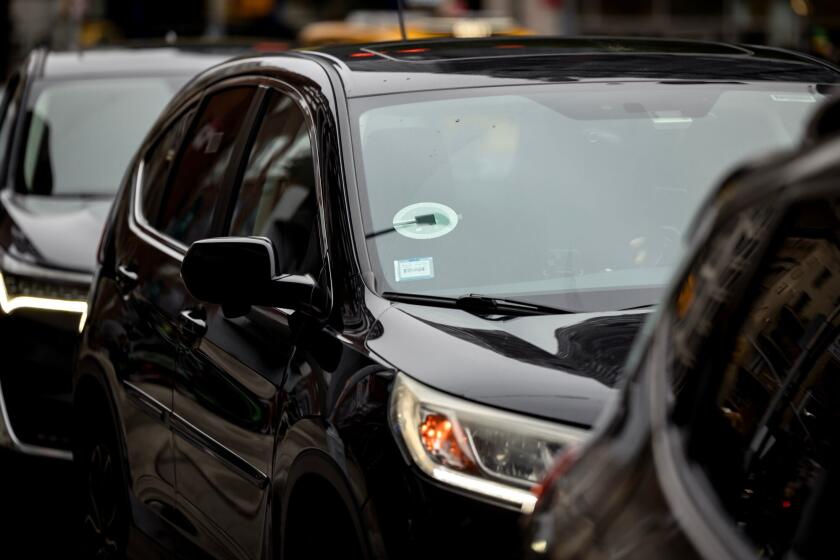Nissan’s old campus in South Bay gets ‘flipped’
- Share via
When word leaked out in 2005 that Nissan Motor Co. planned to move its U.S. headquarters to Tennessee, Southland officials and business leaders pitched a fit.
It was another blow to the collective ego of Southern California, which has seen a disheartening exodus of corporate headquarters. Northrop Grumman Corp.’s recent announcement that it will move to Washington came on the heels of other departures, including Hilton Hotels Corp. from Beverly Hills, Computer Sciences Corp. from El Segundo and Fluor Corp. from Orange County.
Nissan’s plan was treated with alarm by officials, who made a last-ditch effort to keep the automaker in town. Unswayed, Nissan brass turned out the lights and moved their North American headquarters to Nashville in the summer of 2006. After nearly 50 years in Los Angeles County, Nissan’s nerve center was gone.
Left behind was a cluster of 13 buildings, including a nine-story tower topped with a red Nissan sign that was a familiar sight to drivers passing the intersection of the Harbor and San Diego freeways. More than 700,000 square feet of office and light industrial space lay empty.
In Rust Belt cities such as Detroit, many abandoned commercial buildings fall slowly to pieces. But in a sign of the vitality and adaptive nature of the Southern California economy, the 42-acre Nissan campus has been taken over by 11 different businesses that are expected to employ more workers than Nissan did -- about 1,400 in all.
The last piece of the campus will be resurrected by Kaiser Foundation Health Plan, which recently agreed to buy a rambling three-story office building, built by Nissan in 1984, for $13.8 million. Kaiser plans to consolidate its South Bay operations there.
“A lot of people were afraid the Nissan property was going to just sit there for a while,” said economist Jack Kyser of the Los Angeles County Economic Development Corp. “This is a good sign.”
But he was still a bit steamed about how aggressively Tennessee wooed Nissan: with $197 million in state, city and county subsidies, according to local media. “They were literally bought,” Kyser said.
Nissan sold its campus in 2006 to Kearny Real Estate Co. for more than $75 million. Kearny gambled that it would be able to fix up the property and sell it at a profit, much as home “flippers” buy and improve houses to sell. The company expects to gross about $100 million from property sales and development on the site.
Kearny faced several challenges, starting with the pedestrian bridges that Nissan employees used to call “hamster runs” that crossed Figueroa and 190th streets to connect the main tower with other parts of the campus. If the buildings were going to have separate owners, the bridges had to go.
Kearny turned Nissan’s cafeteria and fitness center into an office building, reconfigured parking and made cosmetic changes to other buildings. The most difficult work, though, was behind the scenes as Kearny sought approval from local officials to carve up the site into bite-sized pieces for companies much smaller than Nissan.
“The things you don’t see were the hard part,” said Tony Nobuyuki, a partner at Kearny, who oversaw the transformation of Nissan’s old buildings.
Nissan’s long presence has nearly been erased, absorbed by a variety of companies that reflect the diversity of the region’s economy. Among them are fashion designers, technology firms, a sushi restaurant chain’s food preparation site and an outpost of a Singapore cargo logistics company.
In front of Nissan’s old executive tower lies a well-tended garden and pond at what is now the U.S. headquarters of Taiwanese tire distributor Tireco Inc. Across Figueroa, workers in static-resistant smocks assemble complex electronic parts in a high-ceilinged industrial building that was once a Nissan training facility. Now it’s home to Qual-Pro Corp., which is the kind of manufacturing business that public planners encourage because it provides well-paying blue-collar jobs and doesn’t create the pollution associated with traditional industrial plants.
Much of the company’s work for military and other customers is confidential. But co-owner David Shane disclosed that components Qual-Pro is working on will be used to prevent brain injuries to soldiers by measuring how hard and from what direction their helmets were hit by projectiles -- flagging situations where emergency care is needed.
Qual-Pro spent several million dollars turning the 55,000-square-foot Nissan building into its new headquarters in 2008 as it quintupled the amount of space it had in its former plant just down the street. Shane was offered financial incentives to move operations to Santa Clarita, but was afraid he would lose skilled workers. “We are keeping manufacturing in L.A.,” Shane said. “Blue-chippers like Boeing and Raytheon need subcontractors.”
Over the fence from Qual-Pro are the quiet offices of Highridge Costa Housing Partners. The developer of low-income housing turned a former Nissan loading dock into the entrance to its industrial-chic offices.
Across a parking lot in a 1960s brick building is the West Coast showroom of the Hause of Howe, a subsidiary of Seattle clothier Unionbay, where fashion designer Jade Howe’s company works on men’s clothing designs. Howe has described his premium sportswear line as “cowboy punk meets English country gentleman.”
Nissan’s cafeteria and gym have become headquarters to Pacific Transportation Federal Credit Union, which has served transportation workers since 1939. A $21.1-million revamp added upgrades such as a vault, safety deposit boxes and marble floors.
Moving from leased space in Pasadena gave the credit union “pride of ownership,” said Controller Devric Thomas, and put it closer to a large pool of L.A. County Metropolitan Transportation Authority workers based at a nearby facility.
Nissan is glad to have made the move to Tennessee, spokesman Fred Standish said. It has modern, energy-efficient buildings for about 1,200 employees that are closer to manufacturing plants and other Nissan facilities. About 43% of Nissan’s South Bay employees made the journey, he said.
Standish, who lived in Irvine, couldn’t think of much that he missed about the Los Angeles area besides the climate. “We just had quite a snowstorm,” he said.
Living in Tennessee is cheaper, Standish said, and his commute is shorter.
“The weather isn’t the same,” he said. “Neither is the cost of living.”







